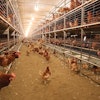
The recent outbreaks of highly pathogenic avian influenza (HPAI) in U.S. layer flocks, in combination with lasting effects of COVID-19, will likely hurt the egg supply chain right before Easter.
So far in 2022, 11.8 million egg-laying hens have been depopulated due to HPAI. These losses have occurred solely in the month of March, with the newest layer-related occurrence being the depopulation of 1.46 million hens in Guthrie County, Iowa. Production is still hurting from the effects of the pandemic, meaning that, in combination with HPAI, supply could be strained going into the egg-based holiday, according to a research brief from CoBank’s Knowledge Exchange.
“The U.S. layer flock typically expands ahead of the surge in demand for Easter and contracts during the summer months. But recent losses due to HPAI have combined with high feed costs and other challenges that are severely limiting flock size management,” stated Brian Earnest, Cobank lead animal protein economist.
According to the United States Department of Agriculture’s (USDA) 2022 Food Price outlook report, an ongoing outbreak of HPAI could contribute to egg price increases due to reduced supply or decreasing international demand. As of March 25th’s U.S. Egg Markets Overview, wholesale prices for graded, loose eggs are continuing to rise and even challenge the increase seen in the early stages of the COVID-19 pandemic. National wholesale prices for White Large shell eggs are approximately $2.10 per dozen.
2015’s HPAI outbreak versus 2022’s
The U.S.’s 2015 HPAI epidemic created egg shortages and price increases.
Egg prices soared after 36 million layers and seven million layer pullets were depopulated. While the outbreak has not become that severe yet, it could be on a similar path. An outbreak of this size was not expected due to significant improvements in control measures over the last seven years. While the spread of HPAI through wild birds is difficult to prevent, experts hope the virus will start to subside after the migratory period ends.


















